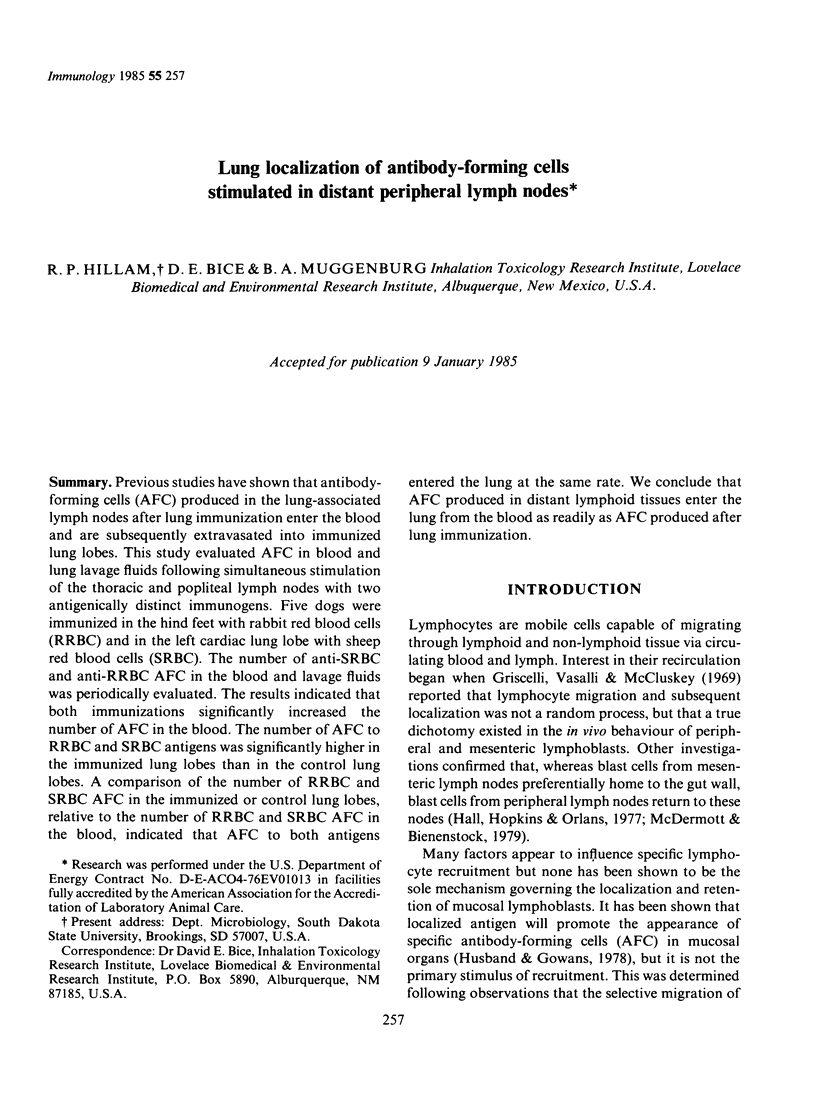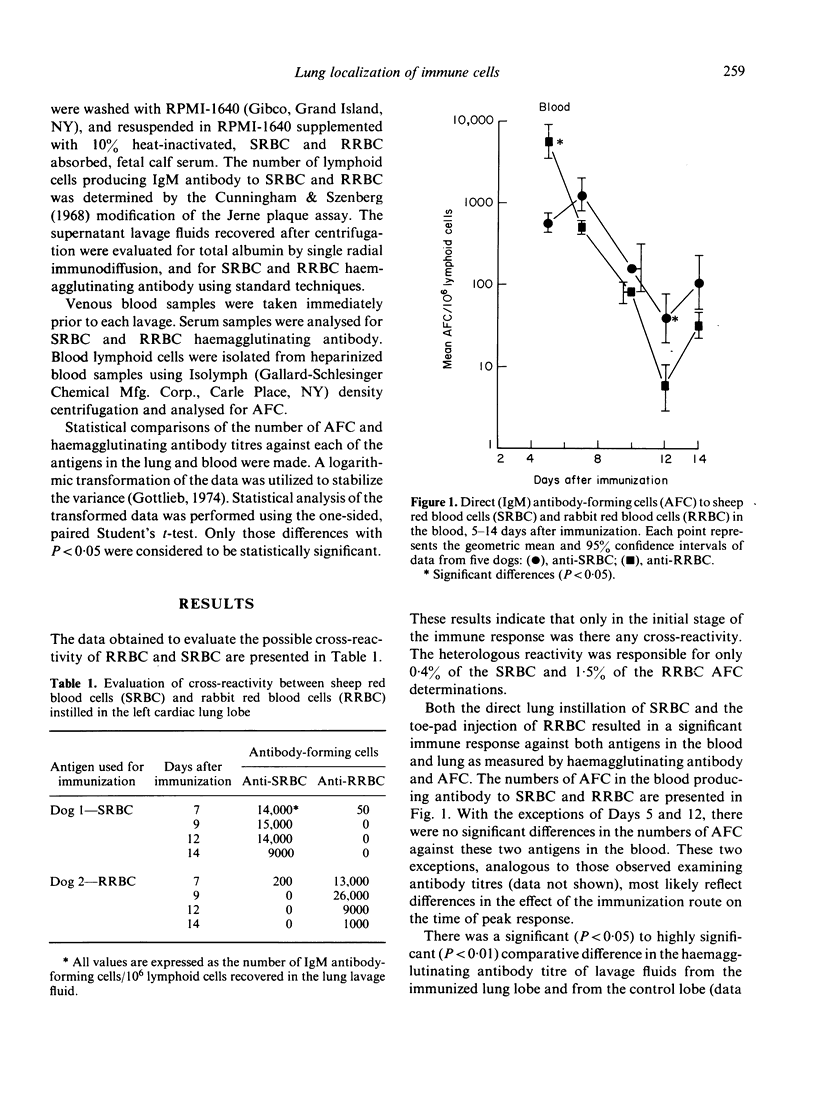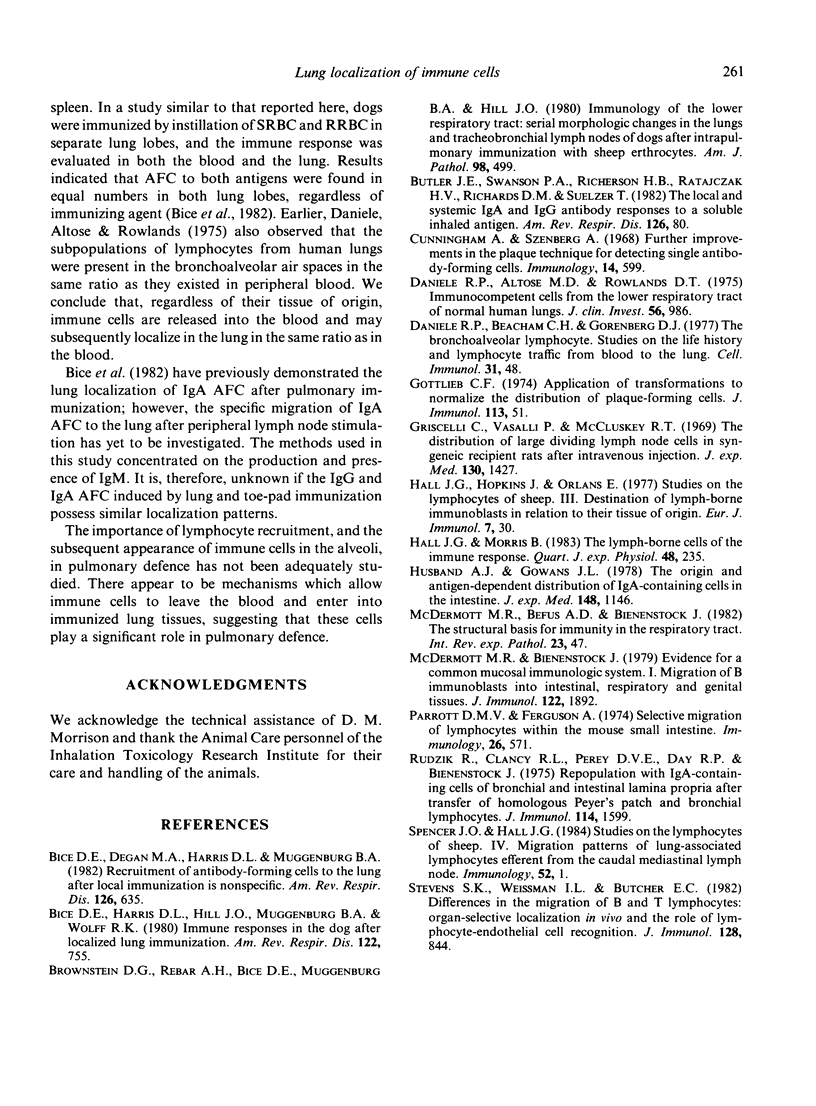Abstract
Previous studies have shown that antibody-forming cells (AFC) produced in the lung-associated lymph nodes after lung immunization enter the blood and are subsequently extravasated into immunized lung lobes. This study evaluated AFC in blood and lung lavage fluids following simultaneous stimulation of the thoracic and popliteal lymph nodes with two antigenically distinct immunogens. Five dogs were immunized in the hind feet with rabbit red blood cells (RRBC) and in the left cardiac lung lobe with sheep red blood cells (SRBC). The number of anti-SRBC and anti-RRBC AFC in the blood and lavage fluids was periodically evaluated. The results indicated that both immunizations significantly increased the number of AFC in the blood. The number of AFC to RRBC and SRBC antigens was significantly higher in the immunized lung lobes than in the control lung lobes. A comparison of the number of RRBC and SRBC AFC in the immunized or control lung lobes, relative to the number of RRBC and SRBC AFC in the blood, indicated that AFC to both antigens entered the lung at the same rate. We conclude that AFC produced in distant lymphoid tissues enter the lung from the blood as readily as AFC produced after lung immunization.
Full text
PDF




Selected References
These references are in PubMed. This may not be the complete list of references from this article.
- Bice D. E., Degen M. A., Harris D. L., Muggenburg B. A. Recruitment of antibody-forming cells in the lung after local immunization is nonspecific. Am Rev Respir Dis. 1982 Oct;126(4):635–639. doi: 10.1164/arrd.1982.126.4.635. [DOI] [PubMed] [Google Scholar]
- Bice D. E., Harris D. L., Hill J. O., Muggenburg B. A., Wolff R. K. Immune responses after localized lung immunization in the dog. Am Rev Respir Dis. 1980 Nov;122(5):755–760. doi: 10.1164/arrd.1980.122.5.755. [DOI] [PubMed] [Google Scholar]
- Brownstein D. G., Rebar A. H., Bice D. E., Muggenburg B. A., Hill J. O. Immunology of the lower respiratory tract. Serial morphologic changes in the lungs and tracheobronchial lymph nodes of dogs after intrapulmonary immunization with sheep erythrocytes. Am J Pathol. 1980 Feb;98(2):499–514. [PMC free article] [PubMed] [Google Scholar]
- Butler J. E., Swanson P. A., Richerson H. B., Ratajczak H. V., Richards D. W., Suelzer M. T. The local and systemic IgA and IgG antibody responses of rabbits to a soluble inhaled antigen: measurement of responses in a model of acute hypersensitivity pneumonitis. Am Rev Respir Dis. 1982 Jul;126(1):80–85. doi: 10.1164/arrd.1982.126.1.80. [DOI] [PubMed] [Google Scholar]
- Cunningham A. J., Szenberg A. Further improvements in the plaque technique for detecting single antibody-forming cells. Immunology. 1968 Apr;14(4):599–600. [PMC free article] [PubMed] [Google Scholar]
- Daniele R. P., Altose M. D., Rowlands D. T., Jr Immunocompetent cells from the lower respiratory tract of normal human lungs. J Clin Invest. 1975 Oct;56(4):986–995. doi: 10.1172/JCI108179. [DOI] [PMC free article] [PubMed] [Google Scholar]
- Daniele R. P., Beacham C. H., Gorenberg D. J. The bronchoalveolar lymphocyte. Studies on the life history and lymphocyte traffic from blood to the lung. Cell Immunol. 1977 Jun 1;31(1):48–54. doi: 10.1016/0008-8749(77)90005-3. [DOI] [PubMed] [Google Scholar]
- Gottlieb C. F. Application of transformations to normalize the distribution of plaque-forming cells. J Immunol. 1974 Jul;113(1):51–57. [PubMed] [Google Scholar]
- Griscelli C., Vassalli P., McCluskey R. T. The distribution of large dividing lymph node cells in syngeneic recipient rats after intravenous injection. J Exp Med. 1969 Dec 1;130(6):1427–1451. doi: 10.1084/jem.130.6.1427. [DOI] [PMC free article] [PubMed] [Google Scholar]
- HALL J. G., MORRIS B. The lymph-borne cells of the immune response. Q J Exp Physiol Cogn Med Sci. 1963 Jul;48:235–247. doi: 10.1113/expphysiol.1963.sp001660. [DOI] [PubMed] [Google Scholar]
- Hall J. G., Hopkins J., Orlans E. Studies on the lymphocytes of sheep. III. Destination of lymph-borne immunoblasts in relation to their tissue of origin. Eur J Immunol. 1977 Jan;7(1):30–37. doi: 10.1002/eji.1830070108. [DOI] [PubMed] [Google Scholar]
- Husband A. J., Gowans J. L. The origin and antigen-dependent distribution of IgA-containing cells in the intestine. J Exp Med. 1978 Nov 1;148(5):1146–1160. doi: 10.1084/jem.148.5.1146. [DOI] [PMC free article] [PubMed] [Google Scholar]
- McDermott M. R., Befus A. D., Bienenstock J. The structural basis for immunity in the respiratory tract. Int Rev Exp Pathol. 1982;23:47–112. [PubMed] [Google Scholar]
- McDermott M. R., Bienenstock J. Evidence for a common mucosal immunologic system. I. Migration of B immunoblasts into intestinal, respiratory, and genital tissues. J Immunol. 1979 May;122(5):1892–1898. [PubMed] [Google Scholar]
- Parrott D. M., Ferguson A. Selective migration of lymphocytes within the mouse small intestine. Immunology. 1974 Mar;26(3):571–588. [PMC free article] [PubMed] [Google Scholar]
- Rudzik R., Clancy R. L., Perey D. Y., Day R. P., Bienenstock J. Repopulation with IgA-containing cells of bronchial and intestinal lamina propria after transfer of homologous Peyer's patch and bronchial lymphocytes. J Immunol. 1975 May;114(5):1599–1604. [PubMed] [Google Scholar]
- Stevens S. K., Weissman I. L., Butcher E. C. Differences in the migration of B and T lymphocytes: organ-selective localization in vivo and the role of lymphocyte-endothelial cell recognition. J Immunol. 1982 Feb;128(2):844–851. [PubMed] [Google Scholar]


